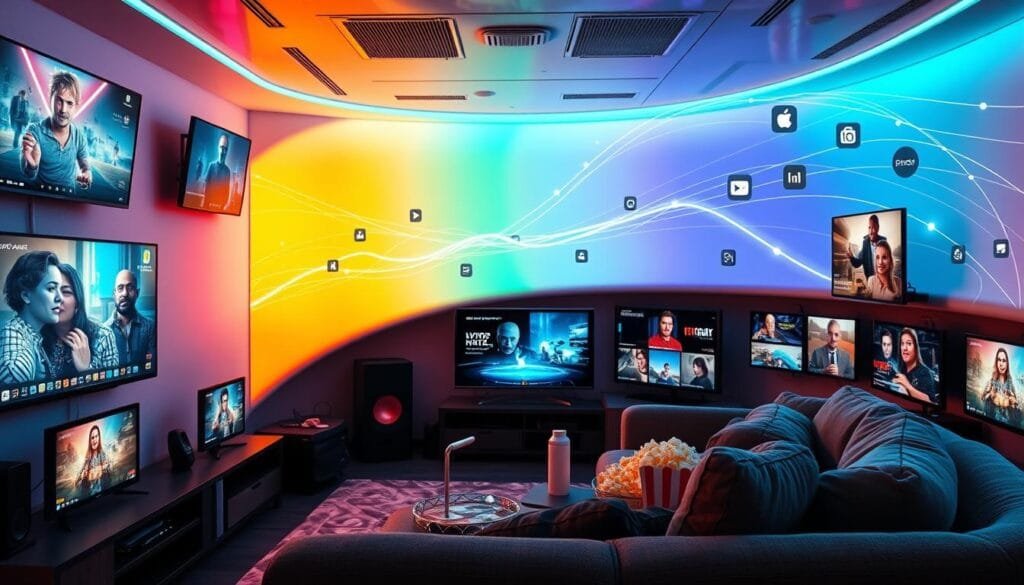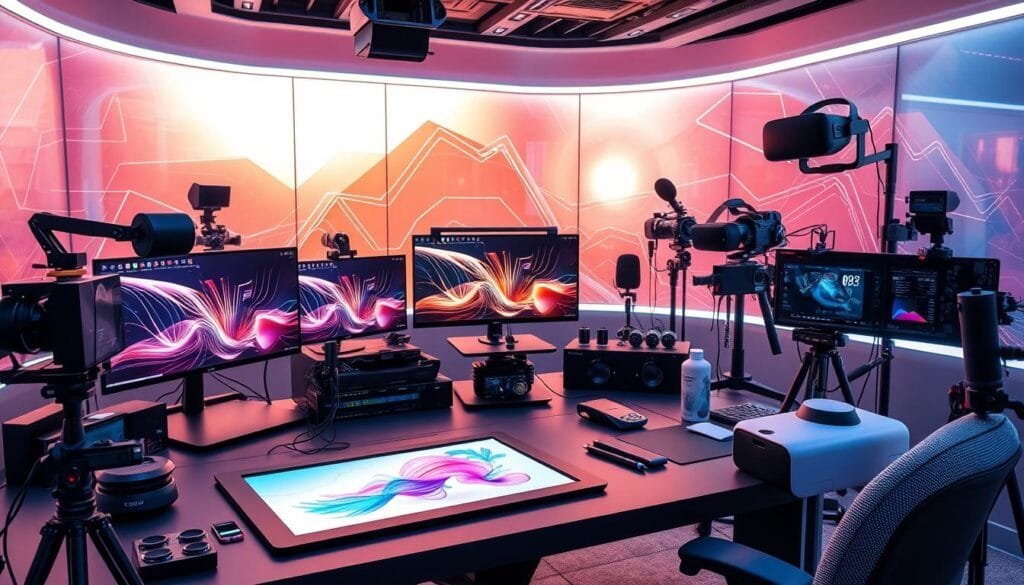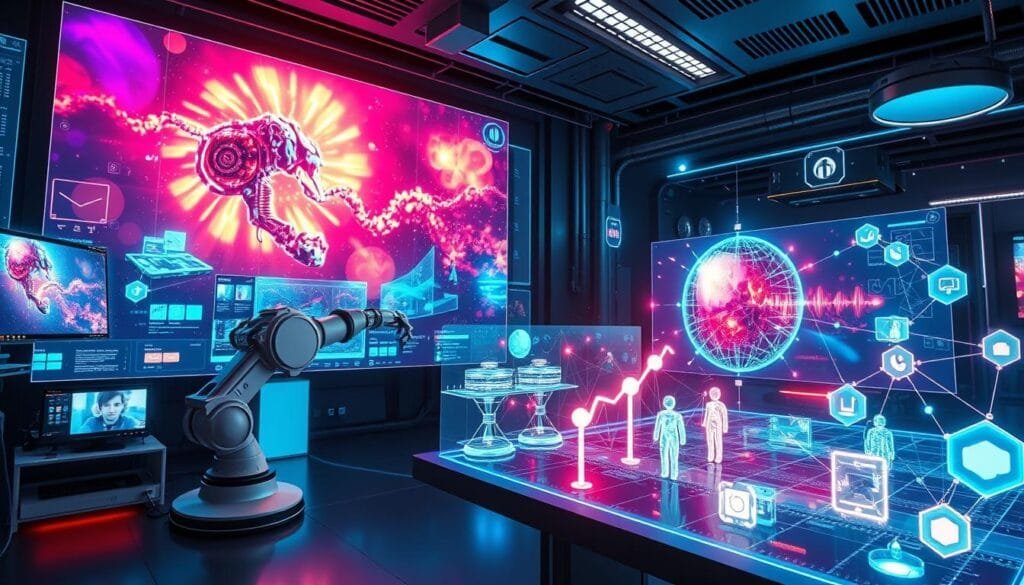In today's fast-paced world, the rise of media technology is reshaping how we make and enjoy content. Traditional media is transitioning to digital spaces. We see the power of tech in how artificial intelligence and virtual reality mix into media. They create new chances for both creators and viewers. This article will cover the journey of media technology, from the past to future predictions. By understanding it, we will grasp its impact and the opportunities it holds.
Key Takeaways
- Media technology is rapidly evolving, affecting how content is created and consumed.
- Traditional media is being transformed by the rise of digital platforms and streaming services.
- AI and VR technologies are becoming crucial in enhancing media experiences.
- The integration of data analytics is reshaping audience engagement strategies.
- Future trends in media technology will focus on sustainability and innovation.
Understanding Media Technology
Media technology includes tools and systems for creating and sharing content. It shapes how we communicate and engage with each other. Its power transforms stories and connects people worldwide.
Definition and Importance
Digital media like social networks and streaming sites are part of media technology. These tools change how we send and receive messages. This lets creators share their work with more people. Media technology is key for innovation and creating ways to interact.
Historical Context
Media technology has grown from the printing press to the internet. Each step changed how we share information. The internet especially started a new era in digital media. Here are some major milestones:
| Year | Event | Impact |
|---|---|---|
| 1440 | Invention of the Printing Press | Mass production of books, democratizing knowledge |
| 1895 | First Radio Transmission | Changed communication dynamics, immediate information dissemination |
| 1927 | Introduction of Television | Visual storytelling, reaching wider audiences |
| 1991 | World Wide Web Launch | Global access to information, emergence of digital media |
The Rise of Streaming Services
Streaming services like Netflix, Hulu, and Disney+ have changed the way we watch TV and movies. They offer on-demand content that has shaken up traditional media. Cable TV and broadcast channels are now changing how they share their content.
Impact on Traditional Media
Streaming services are pulling viewers away from TV and radio. They offer endless watching and ease that changes how we watch shows and ads. This shift makes traditional media find new ways to make money and keep viewers.
Recent studies show that streaming is changing the whole industry. Traditional media has to be creative and find new ways to stay relevant.
Future Trends in Streaming Technology
Streaming is about to change even more. Thanks to new tech, like AI, we'll get shows and movies that fit our tastes perfectly. And with things like virtual reality, watching will become even more interactive.
This means streaming will keep growing and changing how we watch shows. It's an exciting time for people who love movies and TV.

| Streaming Service | Content Type | Unique Features | Impact on Traditional Media |
|---|---|---|---|
| Netflix | TV Shows, Movies, Documentaries | Binge-watching, Original Content | Decline in Cable Subscriptions |
| Hulu | TV Shows, Movies | Next-Day Airing, Live TV Options | Increased Competition in Ad Revenue |
| Disney+ | Movies, TV Shows from Disney brands | Family-Friendly Content, Exclusive Releases | Forced Reassessment of Family Programming |
Advancements in Media Technology
Media production technology has changed how we create content. Now, creators have a wide range of tools to tell their stories better. Both amateurs and pros can make engaging content more easily.
Innovative Tools for Content Creation
Today's tools open up new possibilities for creativity. Adobe Creative Cloud and Final Cut Pro help with complex edits. Meanwhile, apps like TikTok let users share media in fresh ways. This shift supports the idea that anyone can produce and share media.
Enhancements in Media Delivery Platforms
The way we get content has also gotten better. CDNs and adaptive streaming improve accessibility and quality. Features like low-latency streaming and high-definition make watching videos a great experience. With these tech advances, people enjoy seamless, high-quality content.

The Role of Artificial Intelligence in Media
Artificial intelligence (AI) is changing the media landscape. It helps create and share content in new ways. This change boosts efficiency and lets creators focus on the art of storytelling.
AI makes it easier to handle tasks like writing scripts or designing graphics. This allows for a smoother workflow in content creation.
AI in Content Creation
AI tools are revolutionizing content creation by making the process faster. Take OpenAI's GPT-3, for example. It can write texts or create marketing materials quickly. For video producers, AI speeds up editing and suggests the best clips to use.
This move towards AI asks for a change in traditional media roles. It's important for professionals to embrace and use these new technologies.
Data Analytics for Audience Engagement
Today, knowing what the audience wants is key. Media companies use data analytics to understand viewer habits. This leads to more personalized content and smarter marketing.
By looking at how people browse and interact, companies can improve what they offer. This leads to audiences who are more engaged with the content. Success stories show the power of data-driven strategies in captivating viewers.

| Feature | AI Content Creation | Data Analytics for Engagement |
|---|---|---|
| Purpose | Enhance creativity and efficiency | Understand and optimize audience interactions |
| Tools | GPT-3, automated video editors | Analytics platforms, viewing data analysis |
| Benefits | Increased productivity, faster turnarounds | Improved targeting and content relevance |
| Challenges | Need for human oversight, maintaining authenticity | Data privacy concerns, misinterpretation of metrics |
Virtual and Augmented Reality in Media
Virtual and augmented reality are changing how we engage with media. They offer immersive experiences that capture our attention in new ways. Now, content creators can tell stories that go beyond just watching.
Enhancing User Experience
Virtual reality in media allows users to be part of a story. They can explore and make choices that impact the story. This builds a deeper connection. Augmented reality adds digital info to our physical world. It makes what we see even more interesting.
Both technologies improve our experiences by:
- Bringing us into stories in engaging ways.
- Letting us take part in events or tours from anywhere.
- Offering content that fits what we like.
Using these technologies has big benefits for many types of media. Here's a table that shows how they change our experience compared to traditional media.
| Aspect | Traditional Media | Virtual/Augmented Reality |
|---|---|---|
| User Engagement | Passive viewing experience | Active participation in narratives |
| Information Delivery | Linear storytelling | Interactive and contextual information |
| Emotional Connection | Limited personal interaction | Enhanced emotional involvement and immersion |
Social Media as a Catalyst for Change
Social media platforms have changed the way we make, share, and enjoy content. They've made a big impact, thanks to how algorithms work. These algorithms decide what content we find and interact with. By understanding them, content creators and marketers can better reach the people they want to talk to.
Evolving Algorithms and Their Impact
Social media algorithms change based on what users like and do. These changes really affect what we see online. Platforms like Facebook, Instagram, and Twitter make our feeds fit what interests us. This affects both what we come across and how creators connect with us.
Influencer Marketing and User-Generated Content
Influencer marketing has changed how brands market themselves. Influencers use algorithms to get seen more, creating a personal connection. Then, there's content made by users. It builds trust and feels real. Brands use these strategies to get people involved and spread the word. It's key to match what brands say with online trends.
| Aspect | Influencer Marketing | User-Generated Content |
|---|---|---|
| Engagement | High interaction rates | Authentic consumer connection |
| Brand Awareness | Increased visibility via followers | Organic brand promotion |
| Cost-Effectiveness | Varied influencer rates | Typically low-cost |
| Trust Factor | Dependent on influencer credibility | High due to peer recommendations |
The Future of Media Technology
Media technology is about to greatly change. In the coming decade, we will see new trends and tech. These will make our experiences with media even better. Virtual and augmented reality will let us interact with content in new ways. We will have media that knows what we like, making everything more engaging.
Predictions for the Next Decade
Technology will bring big changes to media. Here are some things we might see:
- AI-driven content will make storytelling and production automatic.
- Virtual reality will give us stories we can step into.
- Better tools for understanding audiences and giving them what they like.
- Media will focus on mobile devices because that's what people use most.
Sustainable Practices in Media Production
Being eco-friendly in media production is getting more important. The big names in the field know we need to use technology without harming the planet. They're thinking about:
- Sharing media digitally to reduce waste.
- Using clean energy to make productions.
- Creating tech that has a smaller impact on the environment.
- Making audiences part of sustainability, encouraging smarter choices.
Using these eco-friendly methods is good for the Earth. It also shows audiences that companies care. By working together, the media world can succeed and help the planet.
| Trends | Impact on Media Technology |
|---|---|
| AI-driven Content | Streamlined production processes and enhanced creativity in content creation. |
| Immersive Experiences | Deepened audience engagement and greater exploration of narratives. |
| Mobile-first Approaches | Increased accessibility to content anytime and anywhere, catering to modern lifestyles. |
| Sustainable Practices | Reduction of carbon footprints and a shift towards responsibility in media production. |
Conclusion
As we look back at media technology's growth, it's more than just passing trends. These breakthroughs are changing how we make, share, and see content. Streaming services are changing the traditional media scene. Also, AI helps us understand what audiences enjoy. Together, creative ideas and tech are making new paths. They lead to better user experiences and easier access for everyone.
Looking ahead, media technology will keep evolving. Media folks will need to use new trends like virtual reality and earth-friendly ways of making content. This is key to keep up and stay competitive. Knowing about these changes and trying out new tools will really help content makers and their audiences.
Embracing new media technology means finding fresh and exciting ways to meet audience needs. It shows the need to adapt to changes. By doing so, people in the media world can get ready for a future filled with tech-driven stories and ideas.
FAQ
What are the key advancements in media technology that have reshaped the landscape?
Digital streaming platforms like Netflix and Hulu have changed how we watch TV. The introduction of AI in making content and using AR and VR has also altered our experiences. These advances have reshaped how we engage with media.
How has the rise of streaming services impacted traditional media?
Streaming services have challenged traditional TV and advertising. As people choose on-demand services, cable TV views and ad revenues drop. This change has pushed traditional media to change how they keep their viewers.
What role does artificial intelligence play in creating content?
AI automates tasks in making content, like writing scripts and editing videos. Tools like OpenAI's language models help produce marketing content. They help make media creation more efficient.
What innovations are currently transforming content creation tools?
New tools, like Adobe Creative Cloud and Final Cut Pro, boost creativity and accessibility. Apps like TikTok let people easily create and share videos. These advancements have changed how content is made.
How can data analytics enhance audience engagement?
Data analytics lets media companies understand what viewers like. This information helps them create content and marketing that fit viewers' tastes. By using data, they can connect better with their audience.
What trends in streaming technology should we be aware of?
We should watch for AI-driven recommendations and interactive experiences. Cloud gaming is also growing. These trends aim to make media more personal and engaging.
What are the emerging practices in sustainable media production?
Reducing carbon emissions, using renewable energy, and cutting waste are key to sustainable media. These practices aim to make creating and sharing content more eco-friendly.
How is social media influencing marketing strategies?
Social media changes marketing with its algorithms and content discovery. Influencer marketing and user-generated content are driving engagement and making brands more visible.
What future predictions are made for media technology?
Future trends include more immersive experiences and AI in content creation. Personalizing how we consume media will change our interaction with content.
How has the historical context of media technology informed its current state?
From the printing press to the internet, each advancement has changed how information is shared. The invention of radio and TV set the stage for today's digital age. These milestones show how each step has shaped our media experience.





